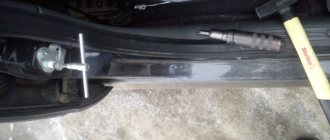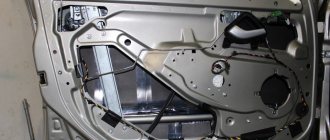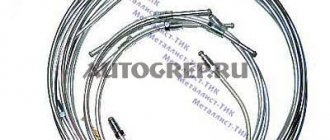If the car engine overheats or the antifreeze temperature does not reach operating temperature, the thermostat may be a possible cause of these malfunctions. There is no difference when replacing the thermostat on Lada cars (Granta, Kalina, Priora, Vesta, Largus, Niva or XRAY) with 8 and 16 valve engines, all actions are performed in the same way.
You will need : drain the coolant, prepare a flathead screwdriver, a Phillips screwdriver, a set of wrenches and silicone sealant.
Procedure:
- Remove the engine air filter housing by disconnecting the hose and the connector with the MAF wires.
- Loosen all thermostat hose clamps (their number may vary depending on the thermostat model).
- Remove the thermostat assembly by unscrewing the two screws securing it and removing the ground connector and the connector with wires from the temperature sensor.
The thermostat is installed in the reverse order, after first cleaning the seat from dirt and applying sealant. The whole process is also shown in the video:
Let us remind you that it is better to check it before installing the thermostat. If this is not the problem, check the cooling system according to the diagram.
As you know, modern cars use a special liquid to cool the power plant. The versatility of this option allows you to simultaneously provide interior heating in winter.
In order for this system to work properly, a special device called a thermostat is also installed in it. In another way, it is also called a coolant temperature regulator. One of its functions is to help the engine warm up as quickly as possible and maintain it in the required condition.
In this article we will talk about how the thermostat of a Grant car is converted to a higher response threshold (92 degrees). In addition, we will tell you about the principle of operation of this device and about possible problems that arise in it.
How does it work
Specifically in Grant, the thermostat is located between the power plant and the radiator. The main task of the unit in question is to prevent the circulation of antifreeze until the engine warms up to the required temperature. If the engine remains cold, the coolant does not move.
Ideally, the thermostat operates after the temperature of the power plant reaches 80-95 degrees. All this allows, among other things, to reduce the volume of emissions harmful to the environment and minimize engine wear.
By the way, checking the functionality of the thermostat is relatively easy. It must be placed in a container with boiling water. If the element is working properly, its valve will open approximately 20 millimeters.
Common faults
Despite the relative simplicity of the device, troubles sometimes occur with it. A malfunctioning thermostat will most likely render the vehicle unable to be driven. More often, its incorrect operation is provoked by the following reasons:
- unstable functioning of the motor (when tripling, the valve is often damaged);
- antifreeze getting inside the device;
- wax flows out;
- mechanical damage to the valve;
- deterioration of the rubber gasket;
However, there is usually one main reason - corrosion.
If for some reason the valve does not open at all, the coolant does not circulate and the power plant overheats. Moreover, the problem will arise regardless of how cold it is outside and how quickly the car accelerates.
Incomplete opening of the valve also causes overheating. True, in this case it will not be critical if external factors do not contribute to this. A delay in closing leads to a prolonged warm-up of the engine, and in winter it most likely will not be able to reach operating temperature.
Revision option
As evidenced by reviews from grant owners, the manufacturer supplies this model with a rather weak thermostat. Usually it opens access to antifreeze after the engine warms up to 80 radii. This is due to low-quality wax inserts, which we described above.
In most cases, such a problem is not perceived as something serious, since it does not harm the operation of the engine in any way. The only drawback is that in winter, when there is frost, the interior can be cool. The situation becomes more complicated if the owner of the car switches to gas.
In this case, it makes sense to modify the thermostat so that it opens at 92 degrees. To do this you will need to purchase a new one. The entire element does not need to be replaced, so only the insert is taken out of the purchased one.
Experts advise choosing the model – VERNET TH4898.92D. Its cost is low - approximately 400 rubles.
The step-by-step replacement procedure is as follows:
- first of all, the car is driven onto a ramp or pit;
- drain antifreeze from the cooling system;
- remove the air duct because it is in the way;
- the thermostat itself is dismantled (but you can leave it in place and only remove the cover from it, the main thing is not to lose the seal);
- the old thermocouple is removed and a new one is inserted;
- they press it with the original spring and limiter.
On average, the response temperature after such a procedure increases by 15 percent.
The whole process is recorded in this video:
All cars whose engines are cooled by a special liquid have at their disposal a device called a thermostat. Lada Granta is no exception.
In the Grant model, the thermostat is located between the radiator and the engine. In the article we will talk about the concept of a car thermostat, what components it consists of and how it functions, and also consider the main types of thermostat malfunctions.
The thermostat is called the antifreeze (antifreeze) temperature regulator in the engine cooling system. It increases the engine warm-up rate and maintains the required thermal state.
The key job of the thermostat is to hold back the flow of radiator fluid until the engine has warmed up. If the engine remains cold, the coolant does not pass through it to the radiator.
The thermostat opens when the engine temperature reaches 95 degrees. Thanks to its operation, the engine warms up faster. Thus, in the Lada Granta, the thermostat reduces the amount of harmful emissions and reduces engine wear to a minimum.
If desired, you can clearly see the operation of the thermostat at home. Place the thermostat in a container filled with water, then place it on the electric stove. As the moment of boiling water approaches, the thermostat valve will open approximately 2 cm. It is recommended to experiment with a new thermostat without removing yours from your own car.
Reviews
| № | Positive |
| 1. | Vasily: I’ve been actively using the car for a year and a half, there are no complaints, the cooling system works stably. I added antifreeze several times because the level was below average, but this is not so critical. |
| 2. | Gennady: after buying the car, I immediately drained the original antifreeze from the interior and filled it with imported antifreeze. The heater operates at full power, the cabin is always warm, and the engine does not overheat. |
| 3. | Vladlen : at 45,000 km the rubber fluid supply pipe burst, replaced it with a new one. I didn’t contact the service center, I handled it myself. |
| 4. | Kirill: in two years of using the car there were no major breakdowns, and minor ones were fixed on my own without the help of a service station. |
| 5. | Dmitry: at 50,000 km, I replaced all the original clamps on the cooling system pipes, since the old ones had lost their tightness and the liquid began to leak. There are no comments about the stove heater. |
| 6. | Denis: mileage 85,000 km, just now replaced the thermostat with a new one. I think that the resource is more than sufficient, as for a domestic car. |
| 7. | Ivan: in three years, I replaced the antifreeze once with a new one, and changed the rubber seal on the body. I am satisfied with the quality of workmanship, there are no particular complaints. |
| Negative | |
| 1. | Victor: low-quality parts, at 45,000 km I replaced the thermostat with a new one, the old one jammed. The antifreeze did not circulate in a large circle due to a malfunction. |
| 2. | Ivan: My regulator lasted for a year and a half, after which the spring jammed. I think that the resource is too small, even for a domestic car. |
| 3. | Vladimir: A year has passed since I bought the car, and I already regret the purchase. Crude assembly, many defects that the manufacturer does not eliminate. |
Adjusting the new thermostat
Conclusion
The cooling system on the Lada Grant is implemented an order of magnitude higher than previous analogues. Direct connection of the stove heater radiator made it possible to achieve maximum heat transfer.
In older versions, the connection was implemented in parallel, which led to heat leakage. Provided you follow the manufacturer's recommendations and take good care of the vehicle, the service life exceeds 80,000 km.
| Video - Granta thermostat. Down with Wahler we put GATES TH00391G2 |
| > |
| Video - Thermostat Grants 92C° route |
Thermostat structure and operating conditions
The thermostat contains metals such as copper and brass alloy. The essence of the device's operation lies in a small cylinder turned towards the engine.
In the middle of the cylinder there is a synthetic wax ball, which at a certain temperature (82 degrees Celsius) begins to melt (the wax expands significantly under the influence of heat, changing its solid state to a liquid).
A special pin is pressed into the wax cylinder and is connected to a valve. When the wax melts, as a result of expansion, it begins to squeeze the pin out of the cylinder, while opening the valve through which coolant flows. When the engine stops and cools, the wax in the thermostat hardens and returns to its solid state.
How to tell if the thermostat is working correctly
In order to find out whether the thermostat is working or not, it is necessary to warm up the engine so that the arrow indicating the temperature does not reach the red mark of the indicator quite a bit.
After that, turn off the engine, go to the hood and open it, look for the upper radiator hose. This rubber hose is usually black in color and is approximately 5cm in diameter.
There are metal clamps at its ends. The upper hose is attached to the top of the radiator. Then we look for the lower hose. It looks like the top one, only it is attached to the bottom of the radiator.
Touch the hoses carefully; they may be hot enough to burn you. If the engine temperature indicator shows that the engine is hot, but one of the hoses is cold, then most likely the thermostat valve is closed and is not allowing coolant through the radiator.
In this case, replace the old thermostat with a new one as quickly as possible (after waiting until the engine has cooled down).
There is another “folk” method for checking the functionality of the thermostat and it is as follows. Place the thermostat in a vessel with boiled (temperature should be about 100 degrees) water.
Next, we visually observe whether the thermostat valve opens. If it opens, it means it’s working. If not, we replace the damaged one with a new one. The above method involves removing the thermostat from the car.
If the thermostat malfunctions in a car, overheating or, more often, low engine temperature is observed. Such phenomena are associated with the thermostat jamming in one position; as a result, the coolant moves in one circle (large or small). Lack of adjustment of coolant distribution leads to deviations from the engine temperature regime. Thermostat failure is one of the most common problems in a cooling system. To replace the thermostat on a Lada Granta car, the coolant from the cooling system does not need to be completely drained.
You will need: TORX TZO wrench, 13mm socket, Phillips-blade screwdriver.
Adjusting the stroke of the thermoelement
Trimming the heel of the thermoelement rod allows you to increase the temperature of the coolant to 85-90° C. We shorten the rod sequentially, 1 mm at a time. This should be done carefully, as its metal is quite soft. Each time after trimming, you need to install a thermostat in the car and monitor the temperature of the fluid while driving. If it does not satisfy you, the rod is shortened by another 1 mm. And so on until the temperature in the cooling system reaches 90-92° C, and the air in the cabin warms up to the required temperatures.
Removing the thermostat Lada Granta
The thermostats of the 8-valve engines and the 16-valve Lada Granta engine are located differently, and therefore their replacement for these engines is shown separately. To remove the thermostat of the VAZ-11183, VAZ-21116 and VAZ-11186 engines, do the following: 1. Remove the plug from the expansion tank. Unscrew the drain plug at the bottom of the right radiator tank. Drain the coolant that comes out of the engine radiator into a container. Screw the drain plug back in.2. Release the clamp on the coolant temperature sensor wiring harness. 3. ...and disconnect the block from the sensor
4. Loosen the clamp securing the rear hose to the thermostat cover...
5. ...and remove the hose from the cover fitting
6. Similarly, disconnect the front hose from the thermostat housing pipe.
7. Unscrew the nut securing the ground wire to the upper stud securing the thermostat housing...
8. ...and remove the nut, washer and wire end from the stud.
Instructions for replacing a faulty element
Dismantling work begins with draining the coolant. Then you need to free access to the thermostat, which will require removing the air filter. You should also remove the hose that supplies air to the throttle assembly. After this, you will press the lock of the block with the wires of the motor control system and disconnect the block.
The next step is to unscrew the nut attaching the tip of the “mass” wire to the thermostat and remove it. Then the tightening on the fastening clamp of the supply hose is loosened, after which it is removed from the pipe. The hose supplying fluid to the heater radiator is also disconnected in the same way.
Next, the nuts securing the thermostat housing itself are unscrewed, after which the housing is removed. The place where the housing connects to the cylinder heads is always sealed with a gasket. Therefore, unscrew the screws that secure the thermostat cover and remove it. In addition, a rubber ring seals the place where the lid is connected to the body. By pressing the locking plate with pliers and carefully turning it in different directions, remove this element from engagement with the protruding parts of the body. Then you need to remove the thermostat spring, after which the cylinder is removed from the thermostat.
Installing a new device involves exactly performing the steps described above in exactly the opposite order.











